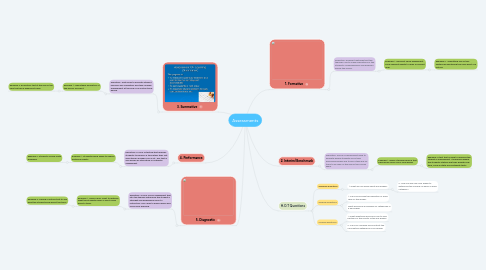
1. 3. Summative
1.1. Definition: Tests used to evaluate student learning. skill acquisition and their acadeic achievement at the end of an instructional period.
1.1.1. Example 1: High stakes evaluation at the end of a project.
1.1.1.1. Example 2: Evaluation test at the end of the year that has a high point value.
2. 4. Performance
2.1. Definition: A form of testing that requires students to perform a task rather than just selecting an answer from a list. This test is also known as alternative or authentic assessment.
2.1.1. Example 1: Students being asked to explain historical events.
2.1.1.1. Example 2: Students solving math problems.
3. 5. Diagnostic
3.1. Definition: A form of pre-assessment that let's the teacher determine the student's strenght and weaknesses prior to instruction. Also used to guide lesson and curriculum planning.
3.1.1. Example 1: Using a KWL chart to deterine what the students know or don't know about a topic.
3.1.1.1. Example 2: Having a unit pre test to see what the student know about the topic.
4. 1. Formative
4.1. Definition: Different methods that the teachers use to make evaluations of the student's comprehension and progress during the lesson.
4.1.1. Example 1: low point value assessment such asking students to draw a concept map.
4.1.1.1. Example 2: submitting one or two sentences identifying the main point of a lecture.
5. 2. Interim/Benchmark
5.1. Definition: a form of assessment used to evaluate where students are in their learning progress and to see if they are on track to do well on the end of the course exam.
5.1.1. Example 1: When a teacher gives a test periodically every six or nine weeks.
5.1.1.1. Example: A test that is used to measure the student's achievement. It measures where the students started and their growth over time, such as state accountability tests.
6. H.O.T Questions
6.1. Opening Questions
6.1.1. 1. What do you know about bar graphs?
6.1.1.1. 2. How can we use a bar graph to determine the number of bears in each category?
6.2. Guiding Questions
6.2.1. 1. Can you provide the definition of each label of the graph?
6.2.2. What would be an example of categories in a bar graph?
6.3. Closing Questions
6.3.1. 1. What questions would you ask to your partner for the results of the bar graph?
6.3.2. 2. Can you compare and contrast the information gathered in your graph?

